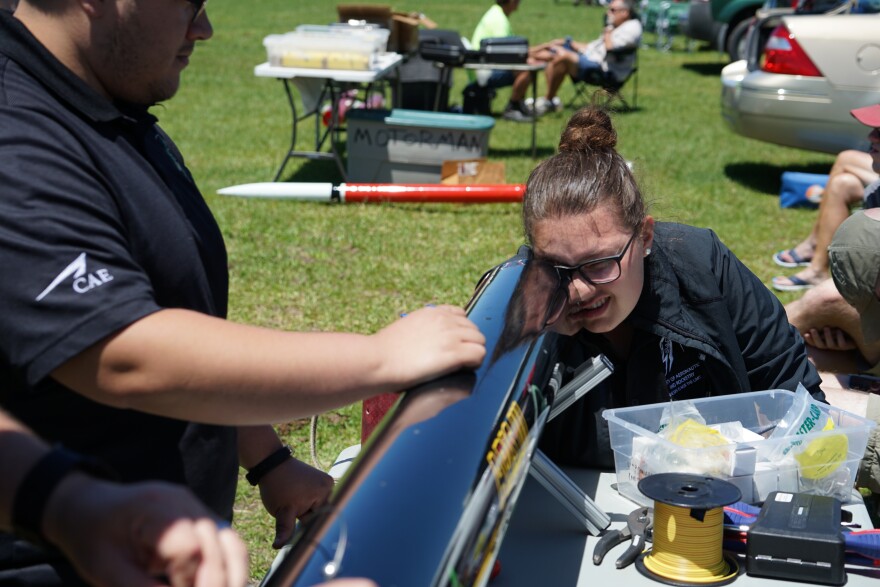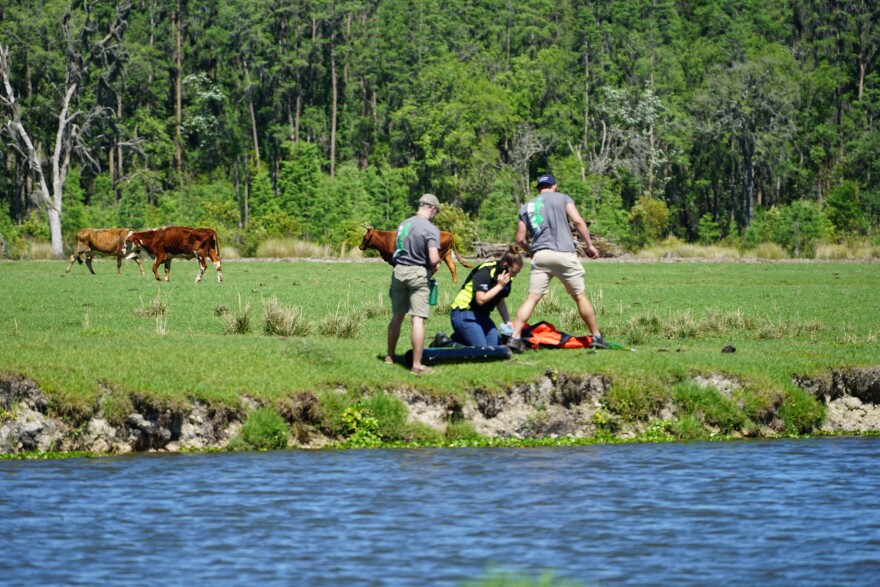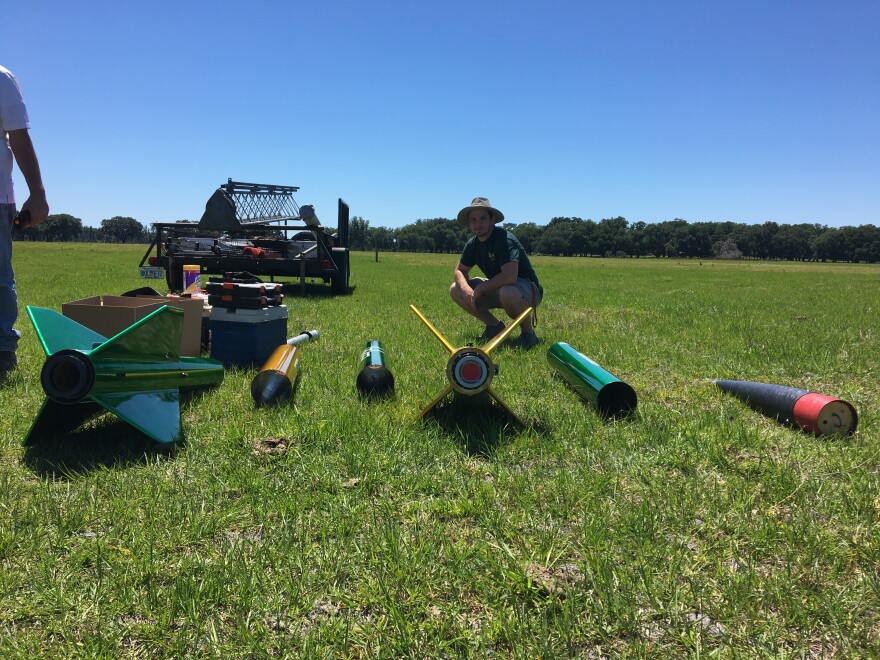Anyone who has ever built and launched a rocket – from a child with a store-bought kit to the NASA scientists who put a human on the moon to Elon Musk – know it’s a saga of many failures and (hopefully) massive successes.
It’s also a story that the members of the University of South Florida’s Society of Aeronautics and Rocketry, or SOAR, are very familiar with.
“Most of our students are engineering majors or physics majors or mathematics majors, and we really just do this for the love of rocketry,” said incoming club president Javian Hernandez.
And like any love, there’s exhilaration and heartbreak – and the students went through those emotions in just one weekend.
One weekend every month, rocket builders from around Florida congregate in a pasture on a Plant City farm to test out their latest crafts. Cows and bulls graze, their peaceful meals interrupted every few minutes by an amplified countdown followed most of the time by the sharp roar of a rocket engine.
It was here that SOAR members went through an eventful two days recently.
First up, they needed to complete a mission for the NASA Student Launch Initiative, a competition that pits university rocket clubs against each other.
“Over a course of eight months, we actually have to build and test a flight vehicle that would deliver a payload,” said Hernandez. “We have to submit five documentation design reviews, and we actually have to go up (to Alabama) for a panel of NASA engineers who actually critique our designs.”

The mission was basically a simulation of a Mars landing: launch a rocket, attain a certain altitude, in this case 4,500 feet, and then land the rocket.
From there, a controller with a computer – in this case, junior Thomas Hall – would signal a device inside the rocket to release its cargo: a 3D-printed, two-wheeled plastic rover vehicle nicknamed the “Nautilus.”
“Once that happens, the deployment system will talk to the rover, the rover will take off and it will drive for around a minute,” said Hall.
Three previous efforts weren’t successful:
- Test flight one, in Plant City: the entire rocket landed in a pond about half a mile from the launch site. “The entire thing was underwater for about an hour and all the electronics got ruined,” said Hall. “So (when) we made the new rover, we called it the ‘Nautilus’ because of its aquatic heritage.”
- Test flight two, also in Plant City: the payload made an early exit. “The rover and the deployment system had some discrepancies in it compared to previous launches, and the rover actually fell out. And again, it got completely destroyed,” said team leader senior Ashleigh Stevenson. “It just fell and just crashed everywhere.”
- Test flight three, at the NASA competition in Alabama: SOAR didn’t get to attempt deployment because of questions over the re-printed rover.

But the students had one more chance, again on their home field in Plant City. While they were optimistic, winds with sustained speeds of around 20 MPH and much higher gusts had them a little worried.
“I just want it to work. I’ve put so much time into this. I just want it to work,” repeated Hall. “Hopefully it does. It would kind of put a lot of gratification into the amount of time and effort and long nights that we’ve all put into this project.”
That hard work – thousands of calculations, hundreds of pages of paperwork, hours of programming and construction and tinkering – came down to this moment.
There was a momentary pause right after the countdown hit one – long enough for Stevenson to audibly gasp – but the rocket lifted off from the pad.
For 40 long seconds, everyone scanned the sky, waiting to see the rocket deploy its chute, so it could land and release the Nautilus rover.
But a sudden, loud, collective groan and one single muttered obscenity indicated something went wrong just moments after the chute opened.
The final launch suffered the same fate as the previous three – failure.
The Nautilus rover had once again split in half, but this time inside the rocket. While part of it crashed to the earth among the cows and the horses and broke into dozens of pieces, the other half stayed in the rocket.
The students didn’t have time to figure out what went wrong, as the wind picked up, filling the parachute and dragging the rocket across the field into yet another small pond.
After pulling the rocket out and setting it on the ground, Hall tried to see if he could get his laptop to sync up with the deployment system to release the now one-wheeled rover and possibly get some partial credit.
But it was too late – wires were wet and ripped loose, and the interior of the rocket was filled with dirt and mud.
“At least we got a picture of it before,” one of the students said with a laugh of resignation.

Afterwards, Hall and Stevenson conducted a quick post-mortem discussion of what they thought went wrong: the rover assembly used a screw on only one wheel, not both, and there were some questions over how the rover’s main body was attached to the side panel. Add in the forces of the launch and that combination was enough to basically shake the Nautilus apart.
“We got to kind of figure out what exactly went wrong in our process,” said Hall. “But from we thought and from what everyone in the club even thought is it like it wasn't going to be an issue because we thought we tested it out.”
“It feels relieved to be over but obviously sucks to see all the hard work go into shambles, all the pieces on the ground, but it was kind of in the back of my mind like oh, it could fall out, it’s fallen out before,” said Stevenson. “But I'm glad that the rocket launch itself went well.”
Despite the deployment failure, USF SOAR still fared well in the NASA Student Launch Initiative. Their craft won best looking rocket and they had the second best rocket fair display, helping them finish tenth out of the 45 universities in the competition.
And after spending years on these projects, the students know that you have to have a short memory and move on to the next mission.
That came the very next day in the same field where they were brought three years of work on another project to and end by conducting the maiden launch of a two-stage rocket named “Taurus.”

The two stages, a booster and sustainer, separate mid-flight when the fuel in the booster burns off. The sustainer then sends a rocket even higher.
Taurus ended up as a record-setter in multiple ways: at 24 feet long and 150 pounds, it’s the largest rocket SOAR ever launched. It also reached the highest altitude the club has ever attained: 11,186 feet.
“I certainly say it was a success,” said SOAR vice president Jackson Stephenson. “The fact that something this massive and tall even got off the round with so much oomph behind it.”
To Stephenson, the weekend was a reminder that this love of rocketry comes with literal and figurative highs and lows.
“It’s a blend of both and it’s nice to see the failures too as well cause it teaches you a lot more things, and all the failures that we’ve had with other projects and other rockets also help to define these ones as well.”
And the members of SOAR are keeping their eyes way up in the sky.
Their next project, which Stephenson said will take up the next few years, is the Base 11 Challenge.
SOAR is one of 16 student teams that will design, build and launch a liquid-propelled, single stage rocket with a target of the Kármán line, an altitude of about 62 miles, where outer space begins.
The prize? Just over $1 million.






















